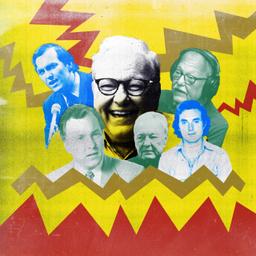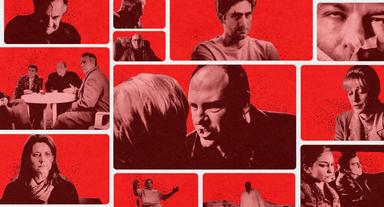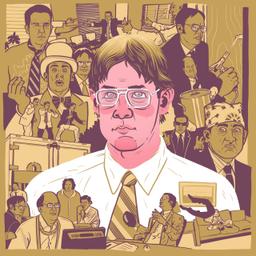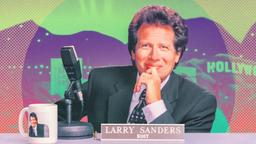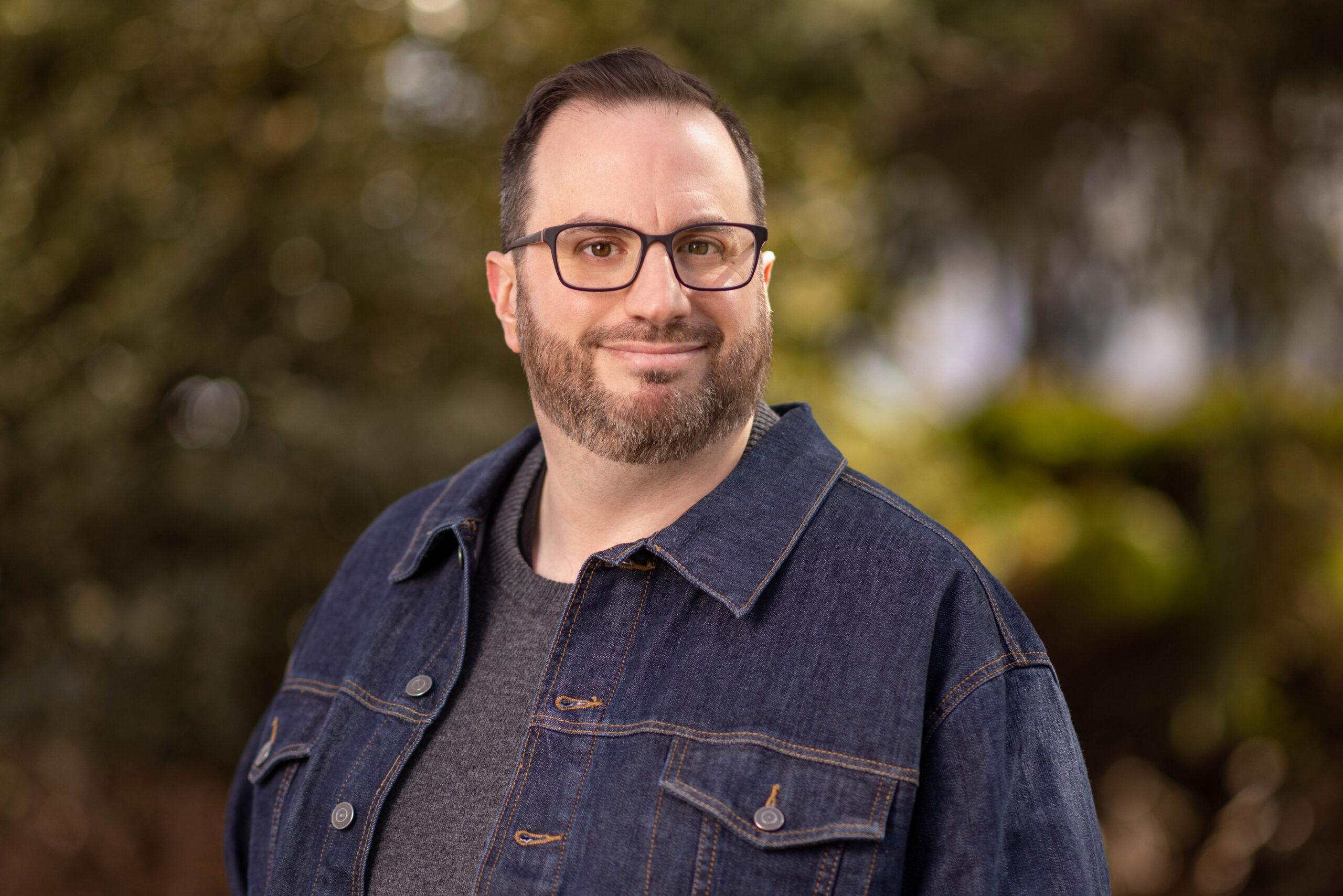When Vince Gilligan’s Pluribus debuted on Apple TV earlier this month, more than a few Breaking Bad fans expressed confusion about why the man who created Walter White and Saul Goodman was making a globe-trotting sci-fi show. Rather than cue up a clip of Schmidt from New Girl complaining about youths, let’s forgive them for not knowing that Gilligan broke into television with The X-Files, writing episodes about shape-shifters with vestigial tails, cancer-eating mutants, alien conspiracies, and more. Pluribus is Gilligan getting back to his roots after 15 years in a world of crystal meth and con artistry.
Looking back at the start of Gilligan’s career is a reminder of what a remarkable team of writers X-Files creator Chris Carter assembled. In addition to Gilligan, X-Files at various points employed:
- Howard Gordon, longtime showrunner of 24 and cocreator of Homeland (along with fellow X-Files alum Alex Gansa)
- Frank Spotnitz, who went on to create The Man in the High Castle and several other series
- Tim Minear, who helps run the 9-1-1 franchise and has been a key producer on many brilliant-but-canceled 21st-century dramas, like Firefly and Terriers
- Darin Morgan, who may have the greatest small-sample-size career of any TV writer, having written only about a dozen episodes ever across multiple series, all of them bangers (most notably The X-Files’ “Clyde Bruckman’s Final Repose,” with Peter Boyle as a psychic who warns Fox Mulder about the dangers of autoerotic asphyxiation)
- A handful of other writers who have worked constantly since the ’90s, including Thomas Schnauz and John Shiban, who joined Gilligan over in the Heisenberg-verse
Football fans talk a lot about coaching trees—how so many current successful NFL coaches used to work for Mike Shanahan, or how Bill Parcells at various points in his career employed Bill Belichick, Sean Payton, and Tom Coughlin. (This usually extends to discussion of how those trees spawn other trees, with mixed success, like Belichick’s.) But there are TV coaching trees, too, where producers or shows bring together many writers and/or directors who then go on to have amazing careers of their own, and in some cases create their own trees.
What helps a particular show grow a tree like this? It’s not as simple as success breeding more success. When Friends exploded on the scene in the mid-’90s, almost every staff writer was offered a development deal to create what executives hoped would be the next Friends; many are still working today, but the only one who became a hit-maker in his own right was Bill Lawrence (Spin City, Scrubs, Shrinking), and he got fired after Friends’ first season. On the other hand, some of the sturdiest coaching trees sprang from shows that either had small audiences or weren’t looked at in their time as obvious incubators for future stalwarts.
One major answer to the above question is quite simple: reps. Of the dozen shows I picked as having the best coaching trees of all time, 10 were made for broadcast network television, at a time when seasons were at least 22 episodes long. (One of them is from so far back that it made 39 episodes every season—the equivalent of the entire combined runs of two contemporary Netflix shows.) Even the two HBO series included on the list usually made at least 13 episodes per season, which is substantially more than what your average streaming show churns out today. Those longer seasons required bigger staffs, which provided more opportunities for young writers to both break into the business and hone their craft. And because those seasons were filmed on a much longer schedule than all but the biggest hits are granted today, there was time for writers to be on set and pick up other skills along the way. The X-Files was one of the most visually striking television shows made to that point (and still looks great on rewatch), and Gilligan got to watch its directors in action for the better part of seven years before he got his chance to helm an episode; now he’s among the best TV directors ever, in addition to one of the best TV writers.
Some of the series below are notable for mixing things up from episode to episode, helping their staffers to become versatile, and/or allowing lots of different kinds of writers to flourish within the same room. Others were largely the same from week to week in structure and tone; their creators just had a particularly keen eye for talent, which is the most crucial aspect of all of this. Steven Bochco (Hill Street Blues, L.A. Law, NYPD Blue) was one of the most acclaimed showrunners of all time. But his greatest talent was less his own writing than his knack for choosing the best collaborators. (His best series were all ones he cocreated with others.) The star of the show that tops the list was a great performer, but what made him immortal were the young writers he was savvy enough to pluck out of obscurity and give a showcase to.
And as impressive as The X-Files tree is, it’s not the best in TV history. It’s not even in the top five.
Honorable Mention
- Choosing either The Simpsons (which gave us Brad Bird, Conan O’Brien, and Greg Daniels, among many others) or Saturday Night Live (how much time do you have to list all the names?) feels a bit like cheating, because when you’ve been on the air for, respectively, 37 and 51 seasons, you’re of course going to launch a lot of great careers. (The same applies to long-running talk shows.)
- Donald Glover started out as a 30 Rock writer, as did Pitch Perfect writer/Blockers director Kay Cannon. Several other alums—Tracy Wigfield (Great News, Peacock’s Saved by the Bell revival), Sam Means (NBC’s upcoming The Fall and Rise of Reggie Dinkins with 30 Rock star Tracy Morgan), and Luke Del Tredici (Peacock’s Killing It)—have created their own shows, often but not always under the Tina Fey umbrella.
- Dawson’s Creek would have an argument for inclusion just for the sake of Greg Berlanti, who went on to oversee the CW’s entire universe of DC Comics dramas, produce long-running hits like Riverdale and Brothers & Sisters, and create the four-hanky CW drama Everwood. Future White Lotus auteur Mike White also worked on the first two seasons, and several other alums created series after doing time with Joey, Pacey, and Jen.
- Like Friends once upon a time, Rick and Morty has become the go-to writing staff for development deals—and with a higher hit rate so far. Mike McMahan created the terrific animated spoof/tribute Star Trek: Lower Decks. Michael Waldron created Loki and has been entrusted with writing Avengers: Doomsday. (He also cocreated the odd Glen Powell football comedy Chad Powers, so nobody’s perfect.) Jessica Gao also got recruited by Marvel, as creator on She-Hulk: Attorney at Law.
12. The White Shadow (CBS, 1978-81)
The tree: John Falsey and Joshua Brand, Mark Tinker, Thomas Carter, Tim Van Patten, Kevin Hooks
The whole coaching tree concept gets much more literal when applied to a series about the coach of an inner-city high school basketball team. White Shadow creator and frequent director Bruce Paltrow (father of Gwyneth) was a big believer in paying things forward. He gave early jobs to Falsey and Brand, who would go on to create the award-winning hospital drama St. Elsewhere (which in turn spawned a tree that would include future Homicide: Life on the Street showrunner and Oz creator Tom Fontana, and Fontana in turn gave us The Wire’s David Simon) and Northern Exposure, and to Tinker, who would direct and/or produce episodes of half the important dramas of the next quarter century, including ER, NYPD Blue, and Deadwood. Paltrow also encouraged the young actors who played members of the Carver High School team to consider the durability of careers behind the camera. When three of them expressed interest, Paltrow let them shadow him and the show’s other directors. That makeshift film school worked: Carter helmed the legendary Miami Vice pilot, won three Emmys, and has directed films like Save the Last Dance and Coach Carter. Van Patten won two Emmys, was the most prolific Sopranos director, and has worked on shows as varied as Sex and the City and Game of Thrones. Hooks has been directing episodic television for the last 40 years, and got a few shots at the big screen, most memorably helping Wesley Snipes in Passenger 57 to remind the bad guys to always bet on black.
11. The Golden Girls (NBC, 1985-92)
The tree: Mitchell Hurwitz, Marc Cherry, Christopher Lloyd
Susan Harris, the genius behind Soap and the adventures of Dorothy, Rose, Blanche, and Sophia, was part of the Norman Lear writing tree, with early credits on All in the Family and Maude. While reteaming with Maude star Bea Arthur for Golden Girls, she unearthed some creative gold herself: Hurwitz created Arrested Development, Cherry created Desperate Housewives, and Lloyd cocreated Modern Family.
10. Nash Bridges (CBS, 1996-2001)
The tree: Damon Lindelof, Shawn Ryan, Glen Mazzara
If you’ve never looked at its writing credits, the middlebrow Don Johnson/Cheech Marin buddy cop show would seem to be this list’s most surprising entry. But Nash creator Carlton Cuse was good at spotting young writing talent. Ryan went on to create The Shield, one of the key series in the cable drama revolution that transformed TV in the 2000s (and gave us Sons of Anarchy creator Kurt Sutter), and later returned to Nash’s home at CBS for better-than-they-needed-to-be procedural dramas like The Unit and S.W.A.T. Mazzara was The Walking Dead’s showrunner for its second and third seasons after writing for its first (i.e., he was a key figure of the massive hit zombie drama when it was at its best). And Lindelof cocreated 2000s mega-phenomenon Lost (which he later recruited Cuse to help him run) and the amazing (if rarely discussed) The Leftovers, then did the impossible and made a great screen adaptation (albeit an extremely loose adaptation) of Alan Moore’s iconic graphic novel Watchmen. He also helped Lost partner J.J. Abrams reboot the Star Trek films, and is back in the comic book world for HBO’s upcoming Lanterns.
9. A Different World (NBC, 1987-93)
The tree: Yvette Lee Bowser, Gina Prince-Bythewood, Reggie Rock Bythewood
The Cosby Show spinoff launched several notable careers, including Bowser, creator of the classic ’90s hangout comedy Living Single, Prince-Bythewood, and Reggie Rock Bythewood. The latter two, who met on A Different World and later married, have mostly worked in movies—Prince-Bythewood has directed great films like Love & Basketball, The Old Guard, and The Woman King—with occasional pitstops back in TV. It was recently announced that they’ll be returning to help produce the college comedy’s Netflix sequel series.
8. The Sopranos (HBO, 1999-2007)
The tree: Matthew Weiner, Terence Winter, Robin Green, Mitchell Burgess
This is more of a quality over quantity ranking, but when one of the shows in question is Mad Men, that’s quality enough right there. As a writer on the paradigm-shifting Mob show’s later seasons, Weiner pitched HBO on the idea of a period drama about ’60s ad execs; the pay cable channel infamously turned him down, and thus the rise of AMC began. (Last week, HBO Max announced that it would be adding remastered Mad Men episodes to its library next month, in the process righting a historical wrong.) Winter, David Chase’s capo on Sopranos, followed it with a very different kind of HBO show about New Jersey gangsters: the Prohibition period piece Boardwalk Empire, which even got Martin Scorsese to direct the pilot. Where Mad Men operated in the same stratosphere as its predecessor, the more straightforward wise-guy action of Boardwalk was a clear step or two below. But it had sustained periods of greatness (particularly in the season that put Michael Kenneth Williams’s seething Chalky White at the center of the narrative) and won 20 Emmys along the way. Both Weiner’s and Winter’s first series owe various stylistic and thematic debts to the adventures of Tony, Carmela, and Paulie Walnuts. Meanwhile, Green and Burgess’s CBS cop drama, Blue Bloods, never aspired to the ambitions of those other series, but it ran 14 seasons and was your uncle’s favorite show for most of them.
7. The Mary Tyler Moore Show (CBS, 1970-77)
The tree: James Burrows, Ed. Weinberger, Stan Daniels, Glen and Les Charles
If we’re choosing coaching trees based on individuals rather than shows, then Mary Tyler Moore Show cocreator James L. Brooks would be way up on the list, since in addition to MTM and its many spinoffs, he was also responsible for cocreating The Simpsons. And on the movie side, he produced the debut films of Cameron Crowe and Wes Anderson. But even if you just stick to this one series, the ripples are unmistakable. Burrows is the most prolific and celebrated sitcom director ever, and he later cocreated another Hall of Fame comedy, Cheers, with the Charles brothers. (The siblings spent more time writing for spinoff Phyllis than the mothership, but their lone MTM episode—in which Mary inadvertently dates Murray’s father—is a good one.) Post-MTM and pre-Cheers, the trio worked for Weinberger and Daniels on another all-timer, the ensemble sitcom Taxi. And Weinberger was one of the cocreators of The Cosby Show and was sole creator of Amen.
6. The X-Files (Fox, 1993-2002)
The tree: Vince Gilligan, Howard Gordon, Frank Spotnitz, Tim Minear, Darin Morgan, Alex Gansa, Glen Morgan, James Wong
See above. Gilligan’s work alone would put it on this list, but when you add in everybody else (Morgan and Wong ran the X-Files-adjacent Millennium for a while, and Wong later directed multiple Final Destination films), the fingerprints of this show can be found all over the next 30 years of TV drama.
5. The Office (NBC, 2005-13)
The tree: Michael Schur, Mindy Kaling, B.J. Novak, Paul Lieberstein, Justin Spitzer, Lee Eisenberg, Gene Stupnitsky
If we were considering the Simpsons and SNL trees, Greg Daniels would be on both. Instead, he gets his own. After cocreating King of the Hill with Mike Judge, he took on the impossible task of adapting Ricky Gervais and Stephen Merchant’s acidic masterpiece The Office for American television. He succeeded, in part because he put together a murderer’s row of writers with eclectic backgrounds. Schur was a fellow SNL alum; he and Daniels would go on to cocreate Parks and Recreation, and Schur became one of the most reliable comedy showrunners in the business (see also: The Good Place, Brooklyn Nine-Nine, A Man on the Inside, and more). Before The Office began, Kaling was best known for playing Ben Affleck in Matt & Ben, an off-Broadway play she cowrote; Daniels had liked a spec script of hers. Novak had written a couple of episodes of the sitcom Raising Dad, but his most notable credit was acting on Punk’d. Novak was a member of the main Office cast in addition to being on the writing staff, and most of the other writers also wound up acting on the show: Schur as Dwight’s creepy cousin Mose, Kaling as ditzy customer service rep Kelly Kapoor, Eisenberg and Stupnitsky as a pair of Vance Refrigeration employees, and Lieberstein as beleaguered HR rep Toby Flenderson. Lieberstein ran the show in its later years and reteamed with brother-in-law Daniels on several later series, including quasi-spinoff The Paper. Spitzer, a relative TV novice when he joined the third season’s staff, later created Superstore, American Auto, and St. Denis Medical, workplace comedies with more than a little Office DNA. Eisenberg and Stupnitsky wrote movies (Bad Teacher, Good Boys) and created other series like Jury Duty.
4. The Larry Sanders Show (HBO, 1992-98)
The tree: Judd Apatow, Steve Levitan, Paul Simms, Peter Tolan
The roots of much of 21st-century comedy grew from the HBO cult classic starring Garry Shandling (another member of the Norman Lear tree, whose first writing credits were on Sanford and Son) as an insecure late-night talk show host, Jeffrey Tambor as his obsequious sidekick, and Rip Torn as his unflappable producer. Apatow (whose The Ben Stiller Show also has an argument for belonging on this list since it gave early jobs to him, Bob Odenkirk, David Cross, and Janeane Garofalo) would for a time be the single most influential comedy producer, writer, and/or director in the business, with movies like The 40-Year-Old Virgin, Knocked Up, and Anchorman. Levitan created the long-running Just Shoot Me and cocreated Modern Family. Simms gave us NewsRadio, the most underrated of all of NBC’s ’90s sitcoms; served as a veteran voice to Donald Glover on Atlanta and Jemaine Clement and Bret McKenzie on Flight of the Conchords; and was the showrunner for the hysterical TV version of Clement and Taika Waititi’s What We Do in the Shadows. Tolan has had a more eclectic career (including reteaming with Shandling for the bizarre sci-fi comedy film What Planet Are You From?) but found great success cocreating the darkly comedic firefighter drama Rescue Me with Dennis Leary.
3. Roseanne (ABC, 1988-97)
The tree: Joss Whedon, Amy Sherman-Palladino, Chuck Lorre, Norm Macdonald, Danny Jacobson, Bruce Helford
Roseanne Barr hired and fired writers so quickly that at the start of the blue-collar sitcom’s sixth season, she gave all 19 writers on staff numbered T-shirts, since it would be easier for her to refer to them by number than to remember their names. When you employ dozens upon dozens of scribes, you’re bound to periodically find ones who will go on to great things once they no longer have to answer to your mercurial ways. Whedon, of course, turned out to be a problematic boss in his own right, but he also created Buffy the Vampire Slayer, Angel, and Firefly; cowrote Toy Story and (unofficially) Speed; and made the first two Avengers movies. Sherman-Palladino (whose husband and frequent collaborator, Daniel Palladino, also did time on Roseanne) gave us Gilmore Girls and The Marvelous Mrs. Maisel, along with machine gun–paced dialogue that few writers have ever matched. Lorre’s one of the most successful sitcom producers in history, with huge hits like The Big Bang Theory (cocreated with Gilmore Girls alum Bill Prady) and Two and a Half Men, along with countless smaller successes like Mom. And you don’t need me to tell you about Norm Macdonald, who retained such affection for Barr that he later got in hot water when he made sympathetic public comments about her after she got ousted from the Roseanne revival because of her racist tweets. Jacobson created the award-winning Paul Reiser and Helen Hunt hit Mad About You. Helford cocreated The Drew Carey Show, and when the Roseanne revival imploded, he helped adapt it into the Barr-less spinoff The Conners, which ended a seven-season run earlier this year. And that’s not even counting Penelope Spheeris, who had a notable directing career both before (The Decline of Western Civilization) and after (Wayne’s World) her time on the Season 2 writing staff.
2. Hill Street Blues (NBC, 1981-87)
The tree: David Milch, Dick Wolf, Mark Frost, Anthony Yerkovich
Steven Bochco and Michael Kozoll’s ensemble cop show was the most imitated TV drama in the two decades leading to The Sopranos, and it was also responsible for some huge careers—names that really don’t need further explanation from me. But let’s do it anyway: Milch left a teaching job at Yale to work for Bochco; his very first script won the Humanitas Prize. He later reteamed with Bochco to cocreate NYPD Blue, which took the grittiness of Hill Street to another level, and then followed that with the immortal Deadwood, the HBO Western with the most flowery—and the most profane—dialogue in TV history. He’s one of the best to ever do it. Wolf (who joined the writing staff after Bochco was fired and Milch reluctantly took over) went on to create the Law & Order franchise, the Chicago franchise, and the FBI franchise, among a few dozen post–Hill Street series that have made him a sizable fortune. Frost teamed up with David Lynch to create Twin Peaks (heard of it?). Yerkovich, meanwhile, created Miami Vice, yet he somehow rates a distant fourth in this group. And among Bochco alums overall, he’s at best a distant fifth, since David E. Kelley quit his legal career to write for L.A. Law before going on to create Ally McBeal, The Practice, Big Little Lies, and so on. (David Mamet also wrote an episode late in Hill Street’s run, but you can’t really count him since he was already a Pulitzer-winning playwright who’d written multiple films by the time Milch talked him into giving TV a try.)
1. Your Show of Shows/Caesar’s Hour (NBC, 1950-54/1954-57)
The tree: Mel Brooks, Carl Reiner, Neil Simon, Larry Gelbart, Woody Allen
Essentially one series operating under two titles (three if you count the short-lived Admiral Broadway Revue, which preceded Your Show of Shows), the best entry in the ’50s comedy and variety boom starred Sid Caesar, a beefy guy equally adept at physical comedy and verbal silliness. But its true stars were the writers Caesar was canny enough to hire, who would go on to define comedy for the latter half of the 20th century. Brooks is arguably the funniest human being who has ever lived. Reiner created the template for the modern workplace sitcom with The Dick Van Dyke Show (inspired by his time working for Caesar) and would go on to make Steve Martin a movie star with films like The Jerk and All of Me. Simon became the most successful playwright of all time with shows like The Odd Couple, Barefoot in the Park, and Lost in Yonkers. Gelbart created the TV version of M*A*S*H and won multiple Tonys, including one for cowriting A Funny Thing Happened on the Way to the Forum. And Allen (who wrote for several specials that aired after Caesar’s Hour concluded its series run) became … Woody Allen, for good and for ill. It’s by far the oldest show on this list, but it’s also the most impressive coaching tree in TV history so far.
